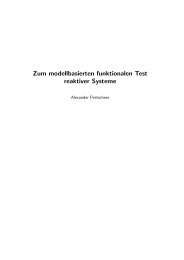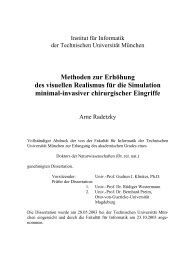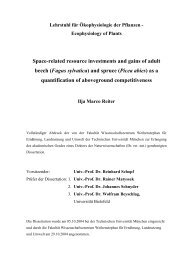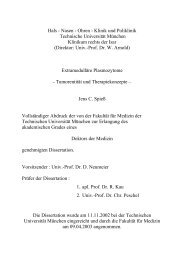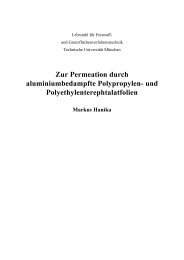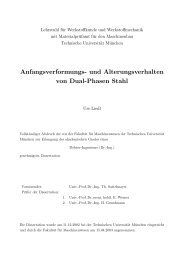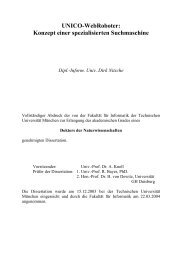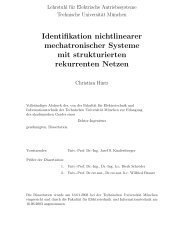Topologically Defined Neuronal Networks Controlled by Silicon Chips
Topologically Defined Neuronal Networks Controlled by Silicon Chips
Topologically Defined Neuronal Networks Controlled by Silicon Chips
Create successful ePaper yourself
Turn your PDF publications into a flip-book with our unique Google optimized e-Paper software.
CHAPTER 3. SINGLE NEURONS ON CHIPS<br />
lation and recording simply <strong>by</strong> connecting them either to a current source or an amplifier circuit. Noise<br />
is very small, on the order of a few microvolt, allowing the measurement of individual action potentials<br />
even from small vertebrate nerve cells such as rat hippocampal neurons.<br />
Despite these virtues, their metallic nature raises several problems. Currents entering from different<br />
locations beneath the cell are integrated <strong>by</strong> the metal layer, resulting in the signal being averaged over<br />
the entire junctional area. This is rather severe if the electrode is only partly covered <strong>by</strong> the neuron, as<br />
signals are short-circuited to the bath, reducing their amplitude considerably. Another issue is that the<br />
measurement process itself can influence the recorded transient. Depending on whether the electrode is<br />
connected to a high impedance operational amplifier or to a low impedance circuit, allowing currents<br />
to flow to ground, the signal is either the voltage or its first temporal derivative (if the capacitance dominates).<br />
While both configurations are used [71, 72, 76], their specific features are not considered even<br />
in detailed theoretical models of the neuron-electrode junction [10, 88]. In consequence, the physics<br />
behind the recorded signal is hardly understood.<br />
Most electrodes are very large, with diameters between 10µm and 50µm, and are usually platinized or<br />
coated otherwise, presumably to improve the signal-to-noise ratio. Surfaces treated in such a way are<br />
mechanically unstable, due to the fine fragile structures that build up.<br />
Complex electrochemical reactions at the metal-electrolyte (cell culture medium) interface, such as local<br />
miniature battery currents and release of metal ions into the electrolyte, may also affect extracellular<br />
recording. Yet they are of much greater concern for stimulation, where voltage or current pulses are<br />
applied to the metal layer [26]. If the voltage between metal and bath exceeds a threshold of about 1.2V,<br />
irreversible electrochemical reactions occur, e.g. electrolysis of water, that are toxic to the tissue and<br />
corrode the electrodes. To minimize such adverse effects, biphasic stimulation pulses with a zero total<br />
charge flow are generally used.<br />
Furthermore, stimulation artifacts often saturate the amplifiers, preventing the recording of neuronal<br />
activity for up to a few tens of milliseconds immediately afterwards.<br />
Most issues discussed above are considerably improved <strong>by</strong> a careful choice of pulse protocol, amplifier<br />
circuit and electrode impedance, enabling reliable stimulation of and recording from cultures of<br />
dissociated neurons and slices with multielectrode arrays. However, a major drawback remains, the ill<br />
defined metal-electrolyte interface.<br />
Field-effect transistors surrounded <strong>by</strong> capacitive stimulators are an interesting alternative for the noninvasive<br />
control of neuronal activity. Due to a thin insulating layer, usually SiO2, electrochemical<br />
reactions are excluded, providing a well defined electrolyte-silicon interface. This allows an accurate<br />
modelling of the signal transfer across the neuron-silicon junction, with the transistor represented <strong>by</strong><br />
a simple capacitance. Also, the measurement itself is of no concern, since the gate voltage directly<br />
modulates the source-drain current without any current flowing across the oxide.<br />
At the present developmental stage one important tradeoff exists; the noise generated <strong>by</strong> field-effect<br />
transistors is substantially higher than in metal electrodes, <strong>by</strong> about a factor of 5 to 10. Action potentials<br />
from small neurons are only detectable when several transients are averaged [113]. Because of<br />
these restrictions, most studies are done with large cells that tightly seal with the chip and generate<br />
strong currents, providing an acceptable signal-to-noise ratio.<br />
Unlike metal electrodes, FETs are still a new extracellular recording technique that offers further room<br />
for improvement. The chances are high that the noise level can be reduced to values comparable to established<br />
techniques <strong>by</strong> employing better semiconductor processes and a different transistor technology.<br />
Moreover, CMOS technology allows easy scale-up, such that devices with several thousand transistors<br />
can be made. Because of these advantages, field-effect transistors are used in the present thesis.<br />
44


